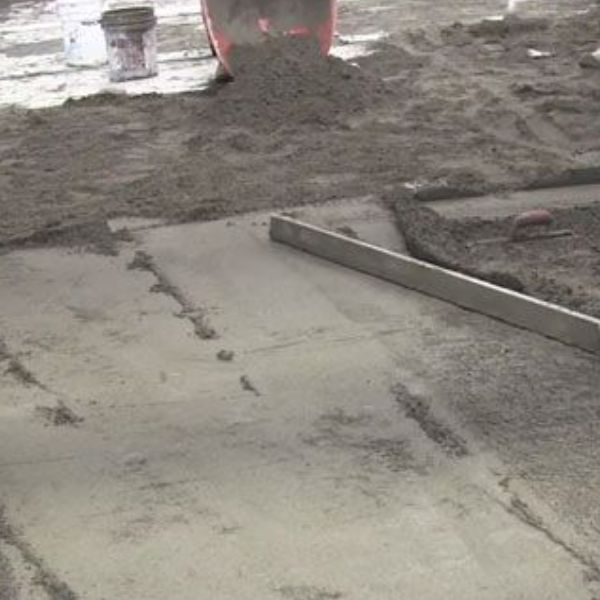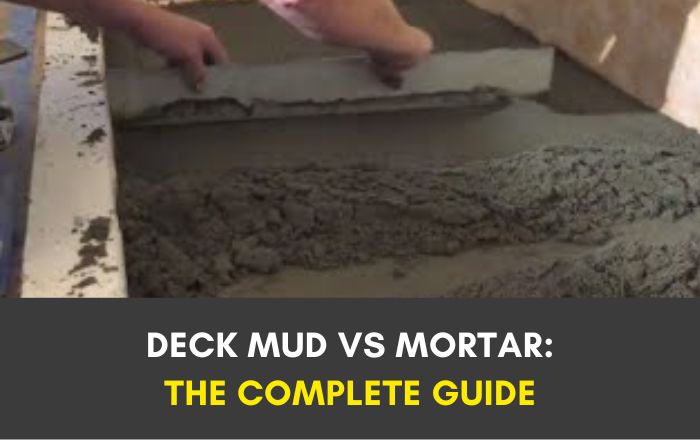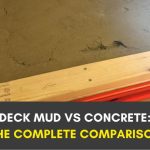Deck mud and mortar are both used for building, but they are different. Deck mud is just cement and sand. It’s not too wet or dry and is kind of thick. It’s good for soaking up shocks. You use it mainly for the base of floors.
Mortar has cement, sand, and lime in water. It’s more liquidy, so it’s easier to shape. Builders use it to stick things like wire mesh to walls and to keep things from falling due to gravity.
Both are used for making floors, but they work differently. Deck mud is good for making a floor you can tile. Mortar is better for connecting bricks or stones in walls.
We’ll compare these two to help you understand what’s good and not so good about each.
Deck Mud: Simple Mix for Strong Floors
Deck mud, also known as dry pack mortar, is a simple mix used in building. It’s made of sand, cement, and a bit of water. You use it for small fixes, filling gaps, making shower bases, and setting tiles and bricks.
It’s good for places that get walked on a lot or where you need the ground to be really even, like floors, countertops, outside areas, and showers.
Deck mud is just sand and cement mixed together, usually in a ratio of 4 parts sand to 1 part cement, up to 7 parts sand to 1 part cement.
You add just enough water to make it sticky when you press it down and smooth it out. The mix with more sand (like 7:1) is best when you’re putting tiles directly on it while it’s still wet. This mix works well for making new, level surfaces.
Deck Mud Pros
- You don’t need special stuff to make deck mud.
- It’s not complicated to work with.
- You can use it inside and outside for things like setting tiles and smoothing walls.
- If you use good materials, the finished surface looks great.
Deck Mud Cons
- Deck mud can sometimes get smaller as it dries.
- It’s not the best choice if you need a really thick layer of mortar.
- To stick well, you have to mix the sand and cement really well.
- The Glue for Bricks and Stones

Mortar
Mortar is like a paste that sticks bricks and stones together in buildings. It’s made from sand, something to bind it together like lime or cement, and water. When you spread it, it’s soft, but then it hardens and keeps everything in place.
Here’s how mortar works
- It’s made of fine sand, water, and a binding material like cement. It’s easy to spread.
- It’s used to join bricks, stones, or concrete blocks.
- Mortar fills the little spaces between bricks or stones, making walls tighter and stronger.
- It creates a smooth layer between bricks or stones so the weight is spread out evenly.
- Sometimes, it’s used to add colors or patterns to walls.
In short, mortar is the material that keeps bricks and stones together in a building, making sure the walls are strong and even.
Mortar Pros
- Mortar keeps bricks or stones from sliding apart.
- It helps make structures more steady.
- No need to smooth each block, as mortar fills in the gaps.
- It touches every part of the block, so weight is shared equally.
- Mortar fills small cracks and gaps, preventing damage.
- You don’t have to spend too much time making it perfect.
- If you mix it right, the quality stays good.
- You can get a nice, smooth surface.
- It’s not hard to apply.
- You can shape it to make sloping surfaces.
Mortar Cons
- Producing cement can harm the environment.
- Getting materials like sand and cement can damage the land.
- Moving sand and cement over long distances affects the environment.
- It’s quite heavy and you have to be careful moving it.
- Getting the right mix takes effort and skill.
- It doesn’t work well in very hot conditions.
- You need some know-how to apply it properly.
- There’s a chance it might get smaller as it dries.
- Getting the right amount of water in the mix can be tough.

Deck Mud vs. Mortar: How They’re Used
Deck Mud Uses
- Deck mud is great for making strong floors. It’s used under tiles, stones, and marble in places like floors, kitchen counters, patios, and shower bases.
- It’s good for areas where a lot of people walk because it’s strong and can handle a lot of bending and pressure.
- It’s also used in outdoor areas with stones or other places where you need a strong, level base.
Mortar Uses
- Mortar is mostly used to stick bricks or blocks together.
- It helps create a flat, even layer between different layers of bricks or stones, which helps spread weight evenly.
- It’s used to fill gaps in brick or stone walls.
- It also acts as a strong base for plastering work, covering up any unevenness and making things look nicer.
- You can also use mortar for decorative purposes, like molding shapes or adding designs.
Deck Mud vs. Mortar: Key Differences Explained
Handling Cracks and Pressure
Mortar is particularly useful for walls because it contains lime, which is good at fixing small cracks. This happens because the lime in the mortar reacts with the air to create a solid that fills in the cracks.
On the other hand, deck mud is more about absorbing pressure rather than fixing cracks. It’s used under tiles and flooring to protect them from cracking under weight. However, unlike mortar, deck mud doesn’t have the ability to repair existing cracks.
Ease of Use and Application
When it comes to using them, deck mud requires a bit more attention, especially in getting the water mix right. The correct water ratio is crucial for ensuring that tiles stick properly to the deck mud. Mortar, in contrast, is generally easier to handle.
The presence of lime in mortar makes it a softer substance, and it doesn’t harden as quickly as deck mud. This slower hardening time allows for easier application and adjustment during construction projects.
Water Resistance and Versatility
One of the significant differences between the two materials is their reaction to water. Mortar, with its lime content, is better at preventing water leakage. It seals off the pores in walls, making them more resistant to water damage over time.
Deck mud, however, has pores that might allow water to pass through, making it less suitable for areas prone to water exposure. Mortar’s ability to block water makes it a better choice for walls, especially in wet conditions.
Cost and Accessibility
Both deck mud and mortar are relatively affordable building materials, making them accessible for various construction projects.
Despite the lime in mortar, it remains within a reasonable price range, making it a viable option for most construction needs. This affordability means that both materials can be used effectively according to their specific purposes without significant cost concerns.
Strength and Flexibility
Deck mud is known for creating a strong base, especially for flooring. It can handle heavy weights, making it ideal for tile support.
Mortar, with its lime component, offers more flexibility. This flexibility is particularly useful in wall construction, as it can adapt to minor shifts and movements without cracking. The interaction of lime with carbon dioxide in the air also helps to fill any minor gaps or cracks that might appear over time.
Durability in Different Applications
Both deck mud and mortar excel in their respective applications in terms of durability. Deck mud is excellent for floorboards, tiles, and areas like bathtubs, where a strong foundation is needed. Mortar, meanwhile, enhances the stability and longevity of structures, particularly in walls.
This distinction in use ensures that both materials play essential roles in both interior and exterior construction projects, contributing to the overall durability and integrity of buildings.
Deck Mud and Mortar: What They’re Made Of
Deck mud and mortar are both used in construction, but they have different ingredients and uses. Here’s a simple breakdown:
Deck Mud
Deck mud is a mix of sand and cement. Usually, people mix one part of cement with four parts of sand. Sometimes, they use one part cement with five to seven parts grit, which is like coarse sand.
You also add water to these dry ingredients, but not too much. The goal is to have a thick, slime-like consistency that sticks well, but isn’t too wet.
Mortar
Mortar includes lime along with cement and sand. A common mix for mortar is one part lime, one part cement, and six parts sand. This was even used by the Egyptians for their wall plasters.
The ideal proportion is three parts sand to every one part of the cement-lime mix. Then, you add water to make it thinner and flowy. It should be easy to spread but still hold its shape.
Both deck mud and mortar are important in construction, but they’re used differently because of what they’re made of and how they work. Deck mud is great for strong, stable bases, especially under tiles. Mortar, with its lime, is better for walls and plastering because it’s smoother and can fill in gaps better.
Final Thoughts
A good builder or contractor really knows their stuff when it comes to using deck mud and mortar. They understand which one to use, when to use it, and how to apply it correctly.
Choosing the right one and using it properly can really make a difference in your construction project.
Deck mud is a mix of sand and cement. It’s tough, good at soaking up shock, and doesn’t let water through. This makes it great for floors, showers, and when you’re laying tiles.
When you need a surface that’s going to last and handle a lot of use, deck mud is the way to go.
Hina Kanwal is the dynamic force behind Deckfaqs.com, blending her expertise in deck design with actionable insights. Known for her engaging content and practical advice, she empowers homeowners to elevate their outdoor spaces. Her passion and knowledge make her a trusted voice in the world of deck-building.







